战略管理期末考试资料整理
- 格式:doc
- 大小:345.00 KB
- 文档页数:25
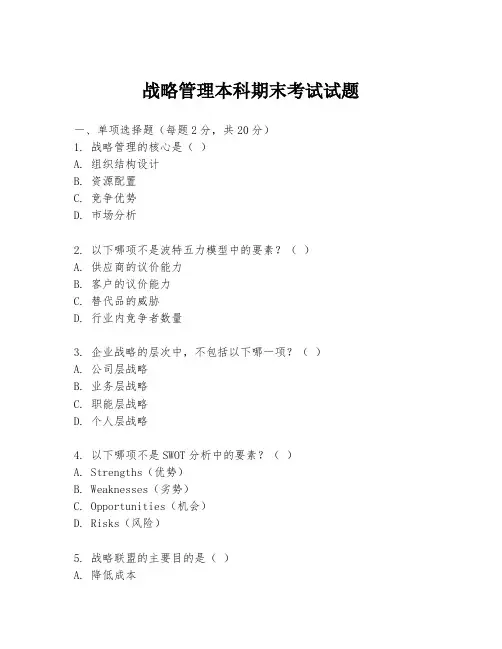
战略管理本科期末考试试题一、单项选择题(每题2分,共20分)1. 战略管理的核心是()A. 组织结构设计B. 资源配置C. 竞争优势D. 市场分析2. 以下哪项不是波特五力模型中的要素?()A. 供应商的议价能力B. 客户的议价能力C. 替代品的威胁D. 行业内竞争者数量3. 企业战略的层次中,不包括以下哪一项?()A. 公司层战略B. 业务层战略C. 职能层战略D. 个人层战略4. 以下哪项不是SWOT分析中的要素?()A. Strengths(优势)B. Weaknesses(劣势)C. Opportunities(机会)D. Risks(风险)5. 战略联盟的主要目的是()A. 降低成本B. 增加市场份额C. 共享风险和收益D. 以上都是6. 企业进行多元化战略时,通常不会考虑以下哪项因素?()A. 市场潜力B. 技术关联性C. 管理能力D. 短期利润7. 以下哪项不是战略实施的关键要素?()A. 组织结构B. 企业文化C. 员工满意度D. 产品定价8. 企业在进行国际化扩张时,通常不会采用以下哪种方式?()A. 出口B. 特许经营C. 直接投资D. 合资企业9. 以下哪项不是企业核心竞争力的特征?()A. 难以模仿B. 稀缺性C. 可替代性D. 持久性10. 企业进行战略评估时,通常不会使用以下哪种工具?()A. 平衡计分卡B. 价值链分析C. 波士顿矩阵D. 市场调研二、简答题(每题10分,共40分)1. 简述战略管理的三个主要过程。
2. 描述波特五力模型,并说明其对企业战略制定的意义。
3. 什么是企业核心竞争力?企业如何培养和保持核心竞争力?4. 企业在进行国际化扩张时,应考虑哪些因素?三、案例分析题(每题20分,共40分)1. 某企业计划进入一个新的市场,但面临激烈的竞争。
请分析该企业应如何制定市场进入战略,并说明可能面临的挑战及应对策略。
2. 某企业在实施多元化战略后,发现资源分散,核心业务受到影响。
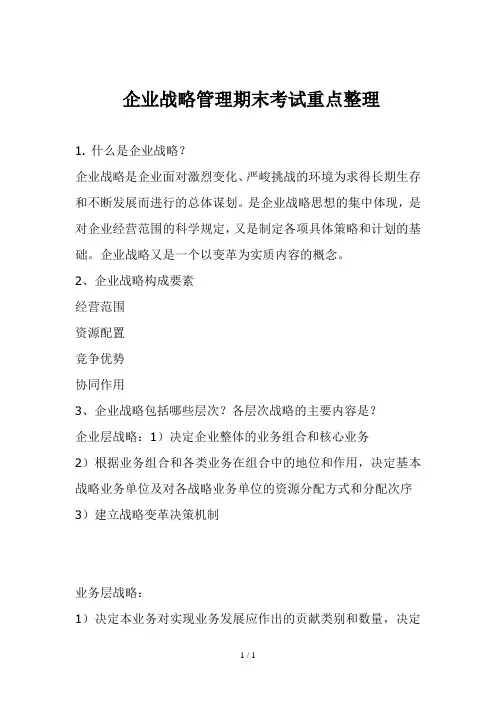
企业战略管理期末考试重点整理1. 什么是企业战略?企业战略是企业面对激烈变化、严峻挑战的环境为求得长期生存和不断发展而进行的总体谋划。
是企业战略思想的集中体现,是对企业经营范围的科学规定,又是制定各项具体策略和计划的基础。
企业战略又是一个以变革为实质内容的概念。
2、企业战略构成要素经营范围资源配置竞争优势协同作用3、企业战略包括哪些层次?各层次战略的主要内容是?企业层战略:1)决定企业整体的业务组合和核心业务2)根据业务组合和各类业务在组合中的地位和作用,决定基本战略业务单位及对各战略业务单位的资源分配方式和分配次序3)建立战略变革决策机制业务层战略:1)决定本业务对实现业务发展应作出的贡献类别和数量,决定本业务的发展方向和发展远景,以及本业务活动与企业内其他业务活动的关系,包括需要与企业内其他业务共享的资源和职能。
2)决定本业务的涵盖范围,明确业务活动所采用的基本技术类型和技术开发潜力,研究其目标市场的类型、结构、竞争状况和变化趋势3)确定本战略业务单位内各项职能在市场竞争中的作用4)制定实现业务发展目标的计划,对各计划期和各方面负责的人员及业务活动进程提出明确要求,并根据计划对本战略业务单位的资源进行分配,建立对业务内各项活动资源使用效果的控制和评价机制。
5)协调和平衡本战略业务单位中的各项职能战略职能层战略:1)明确并满足业务战略成功实施对本职能的具体要求2)确定本职能活动与其他相关活动的关系,寻求本职能与其他职能可以共享的活动和资源。
3)对本职能的各项具体活动进行组织安排4)确定本职能的发展方向和资源分配4、如何理解企业战略管理过程l 战略分析:1)明确企业的使命和宗旨2)外部环境分析3)内部条件分析l 战略选择:1)制定备择战略方案2)评价战略方案3)最终选出供执行的满意战略l 战略实施这阶段主要工作包括计划、组织、领导、和控制四种管理职能的活动。
战略实施的关键在于其有效性。
战略实施成功与否取决于管理者激励员工能力的大小和处理人际关系的技能。
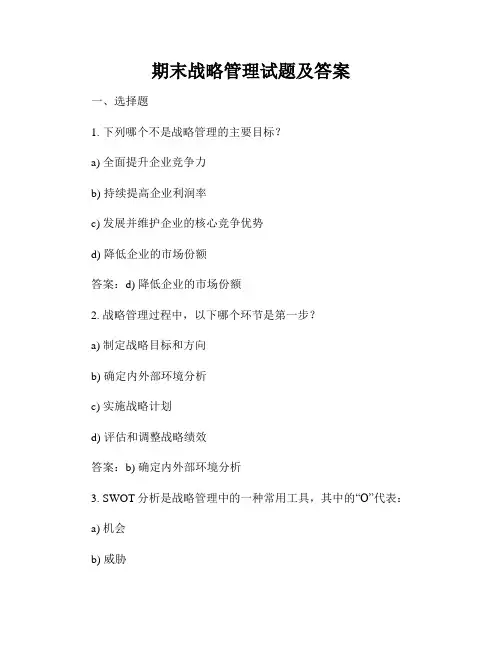
期末战略管理试题及答案一、选择题1. 下列哪个不是战略管理的主要目标?a) 全面提升企业竞争力b) 持续提高企业利润率c) 发展并维护企业的核心竞争优势d) 降低企业的市场份额答案:d) 降低企业的市场份额2. 战略管理过程中,以下哪个环节是第一步?a) 制定战略目标和方向b) 确定内外部环境分析c) 实施战略计划d) 评估和调整战略绩效答案:b) 确定内外部环境分析3. SWOT分析是战略管理中的一种常用工具,其中的“O”代表:a) 机会b) 威胁c) 优势d) 劣势答案:a) 机会4. 核心竞争力是指企业在竞争中相对于其他竞争对手所具备的:a) 产品差异化优势b) 低成本优势c) 高品牌知名度d) 生产规模优势答案:a) 产品差异化优势5. 战略实施的重要内容之一是:a) 制定长期战略目标b) 确定组织结构和职责c) 分析竞争对手策略d) 核心竞争力的持续改进答案:b) 确定组织结构和职责二、思考题1. 请简要说明战略管理的定义及重要性。
战略管理是指企业在长期发展过程中制定和实施的一系列决策和行动,以达到全面提升竞争力、持续提高利润率以及发展并维护核心竞争优势的目标。
战略管理对企业的重要性体现在以下几个方面:- 战略管理能够帮助企业从宏观和长远的角度审视和把握企业的发展方向,避免盲目经营和短视行为。
- 战略管理能够通过对内外环境的全面分析,帮助企业识别机会和威胁,发挥企业的优势和规避风险。
- 战略管理能够加强企业内部资源和能力的整合,实现协同效应,提升企业的竞争力。
- 战略管理能够提供明确的目标和行动计划,引导企业的决策和行动,减少资源的浪费和冲突。
- 战略管理能够帮助企业建立长期的竞争优势,增强企业的市场地位和品牌价值,实现可持续发展。
2. 请列举战略管理过程中常用的工具和方法,并简要解释其应用。
- SWOT分析:通过对企业内部优势和劣势以及外部机会和威胁的分析,帮助企业了解自身优势和劣势,捕捉机会和规避威胁,为制定战略提供参考和依据。
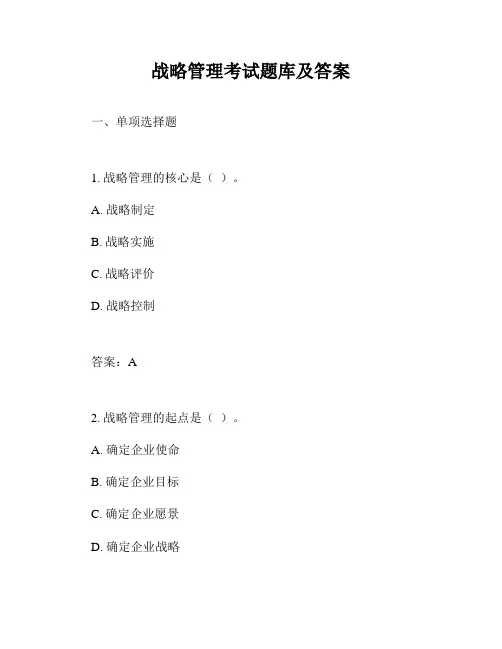
战略管理考试题库及答案一、单项选择题1. 战略管理的核心是()。
A. 战略制定B. 战略实施C. 战略评价D. 战略控制答案:A2. 战略管理的起点是()。
A. 确定企业使命B. 确定企业目标C. 确定企业愿景D. 确定企业战略答案:A3. 企业使命的表述应该()。
A. 具体明确B. 抽象概括C. 包含所有业务D. 只包含核心业务答案:B4. 企业战略的制定需要考虑的外部环境因素不包括()。
A. 政治法律环境B. 经济环境C. 社会文化环境D. 企业内部资源答案:D5. 企业战略的制定需要考虑的内部环境因素不包括()。
A. 企业资源B. 企业能力C. 企业核心竞争力D. 行业竞争状况答案:D6. 企业战略的实施过程中,需要关注的是()。
A. 战略的制定B. 战略的实施C. 战略的评价D. 战略的控制答案:B7. 企业战略的控制过程中,需要关注的是()。
A. 战略的制定B. 战略的实施C. 战略的评价D. 战略的调整答案:D8. 企业战略评价的目的是()。
A. 确定企业使命B. 确定企业目标C. 确定企业愿景D. 确定企业战略答案:C9. 企业战略管理的最终目标是()。
A. 增加市场份额B. 提高企业利润C. 提升企业竞争力D. 实现企业可持续发展答案:D10. 企业战略管理的基本原则不包括()。
A. 系统性原则B. 动态性原则C. 客观性原则D. 随意性原则答案:D二、多项选择题1. 企业战略管理的特点包括()。
A. 系统性B. 动态性C. 客观性D. 随意性答案:ABC2. 企业战略管理的过程包括()。
A. 战略制定B. 战略实施C. 战略评价D. 战略控制答案:ABCD3. 企业外部环境分析的内容包括()。
A. 政治法律环境B. 经济环境C. 社会文化环境D. 技术环境答案:ABCD4. 企业内部环境分析的内容包括()。
A. 企业资源B. 企业能力C. 企业核心竞争力D. 企业组织结构答案:ABCD5. 企业战略实施的步骤包括()。
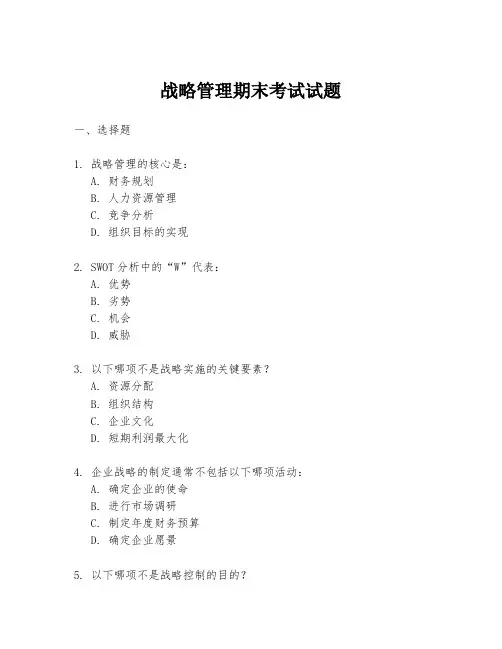
战略管理期末考试试题一、选择题1. 战略管理的核心是:A. 财务规划B. 人力资源管理C. 竞争分析D. 组织目标的实现2. SWOT分析中的“W”代表:A. 优势B. 劣势C. 机会D. 威胁3. 以下哪项不是战略实施的关键要素?A. 资源分配B. 组织结构C. 企业文化D. 短期利润最大化4. 企业战略的制定通常不包括以下哪项活动:A. 确定企业的使命B. 进行市场调研C. 制定年度财务预算D. 确定企业愿景5. 以下哪项不是战略控制的目的?A. 确保战略实施与战略计划一致B. 及时纠正偏差C. 减少风险D. 增加员工的工作量二、简答题1. 简述战略管理的三个主要阶段。
2. 描述平衡计分卡的四个维度,并解释它们如何帮助企业实现战略目标。
3. 什么是核心竞争力?企业如何识别和培养自己的核心竞争力?三、案例分析题案例:某科技公司在快速发展的市场中面临激烈的竞争。
公司管理层正在考虑是否应该进入一个新的市场领域,这个领域与公司现有的业务有一定的关联性,但风险也相对较高。
请分析该公司在制定战略时需要考虑的关键因素。
问题:1. 描述该公司在制定新市场进入战略时可能采用的战略分析工具。
2. 讨论进入新市场可能带来的机遇和挑战。
3. 提出建议,说明该公司应如何平衡风险和机会,制定有效的战略。
四、论述题题目:论述企业如何通过战略联盟来获取竞争优势。
要求:1. 定义战略联盟,并解释其在现代企业中的重要性。
2. 分析战略联盟的类型及其对企业战略的影响。
3. 讨论企业在选择战略联盟伙伴时需要考虑的关键因素。
4. 举例说明战略联盟如何帮助企业实现其战略目标。
五、计算题题目:某公司计划投资一个新的项目,预计初始投资为1000万元,预计每年产生200万元的净现金流。
假设公司的资本成本为10%,计算该项目的净现值(NPV)。
要求:1. 列出计算NPV所需的公式。
2. 计算该项目的净现值,并解释其对公司决策的影响。
注意:本试卷仅供参考,实际考试内容可能有所不同。
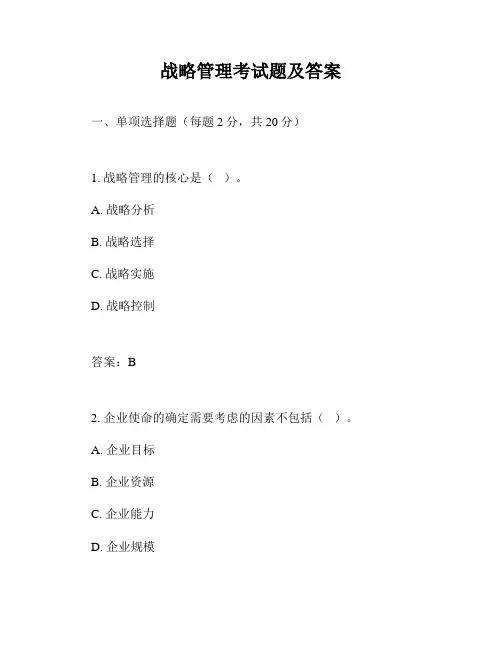
战略管理考试题及答案一、单项选择题(每题2分,共20分)1. 战略管理的核心是()。
A. 战略分析B. 战略选择C. 战略实施D. 战略控制答案:B2. 企业使命的确定需要考虑的因素不包括()。
A. 企业目标B. 企业资源C. 企业能力D. 企业规模答案:D3. 以下哪项不是SWOT分析中的要素?()A. StrengthsB. WeaknessesC. OpportunitiesD. Environments答案:D4. 波士顿矩阵中,市场占有率高且增长率低的产品属于()。
A. 明星产品B. 问题产品C. 金牛产品D. 瘦狗产品答案:C5. 以下哪项不是企业战略的类型?()A. 成本领先战略B. 差异化战略C. 集中化战略D. 多元化战略答案:D6. 企业战略的制定过程不包括以下哪项?()A. 确定企业使命B. 制定战略目标C. 选择战略方案D. 战略评估与控制答案:D7. 以下哪项不是战略实施中的关键因素?()A. 组织结构B. 资源分配C. 企业文化D. 市场调研答案:D8. 企业战略控制的目的是()。
A. 确保战略目标的实现B. 降低成本C. 提高效率D. 增加市场份额答案:A9. 以下哪项不是企业核心竞争力的特征?()A. 价值性B. 稀缺性C. 不可模仿性D. 可替代性答案:D10. 企业战略联盟的主要形式不包括()。
A. 合资B. 合作C. 合并D. 竞争答案:D二、多项选择题(每题3分,共15分)1. 战略管理过程中,战略分析包括以下哪些内容?()A. 外部环境分析B. 内部环境分析C. 竞争对手分析D. 行业分析答案:ABCD2. 以下哪些因素会影响企业的战略选择?()A. 企业资源B. 企业文化C. 行业竞争状况D. 宏观经济环境答案:ABCD3. 企业战略实施中,以下哪些是组织结构调整的考虑因素?()A. 战略目标B. 管理层次C. 管理幅度D. 组织文化答案:ABCD4. 企业战略控制过程中,以下哪些是控制方法?()A. 预算控制B. 非预算控制C. 财务控制D. 非财务控制答案:ABCD5. 企业核心竞争力的来源包括以下哪些?()A. 技术创新B. 品牌优势C. 管理能力D. 人力资源答案:ABCD三、判断题(每题2分,共10分)1. 战略管理是一个动态的、循环的过程。
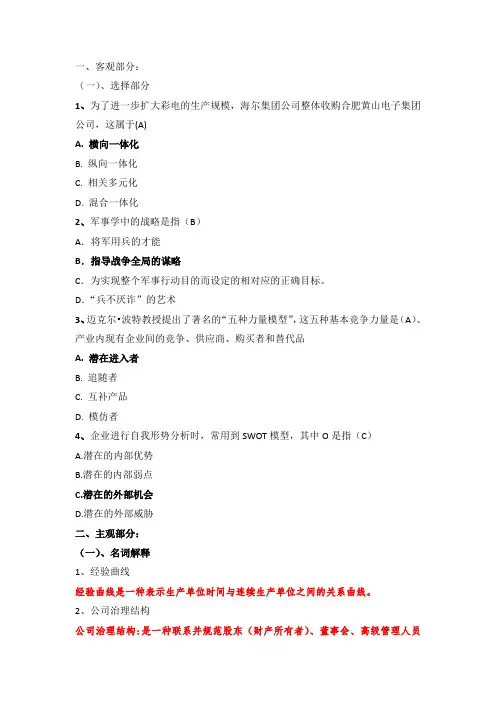
一、客观部分:(一)、选择部分1、为了进一步扩大彩电的生产规模,海尔集团公司整体收购合肥黄山电子集团公司,这属于(A)A. 横向一体化B. 纵向一体化C. 相关多元化D. 混合一体化2、军事学中的战略是指(B)A.将军用兵的才能B.指导战争全局的谋略C.为实现整个军事行动目的而设定的相对应的正确目标。
D.“兵不厌诈”的艺术3、迈克尔•波特教授提出了著名的“五种力量模型”,这五种基本竞争力量是(A)、产业内现有企业间的竞争、供应商、购买者和替代品A. 潜在进入者B. 追随者C. 互补产品D. 模仿者4、企业进行自我形势分析时,常用到SWOT模型,其中O是指(C)A.潜在的内部优势B.潜在的内部弱点C.潜在的外部机会D.潜在的外部威胁二、主观部分:(一)、名词解释1、经验曲线经验曲线是一种表示生产单位时间与连续生产单位之间的关系曲线。
2、公司治理结构公司治理结构:是一种联系并规范股东(财产所有者)、董事会、高级管理人员权利和义务分配,以及与此有关的聘选、监督等问题的制度框架。
3、成本领先战略成本领先战略:也称为低成本战略,是指企业通过有效途径降低成本,使企业的全部成本低于竞争对手的成本,甚至是在同行业中最低的成本,从而获取竞争优势的一种战略。
4、核心能力核心能力:又称核心竞争力,就是能够为企业带来比较优势进而能形成竞争优势的能力和资源。
5、价值链企业的价值创造是通过一系列为基本活动和辅助活动构成的,这些互不相同但又相互关联的生产经营活动,构成了一个创造价值的动态过程,即价值链。
6、规模经济规模经济(economics of scale)又称“规模利益”(scale merit),指随生产能力的扩大,使单位成本下降的趋势,即长期费用曲线呈下降趋势。
7、核心能力是指能使企业长期或持续拥有某种优势的能力,它通常表现为企业经营中的累积性学识,尤其是关于如何协调不同生产技能和有机结合多种技术的学识。
8、标杆学习是一家公司将自己的业绩与一流公司相对比来确定这些公司能达到他们的业绩表现水平,并应用这些信息来改进自己业绩表现的改进的流程。
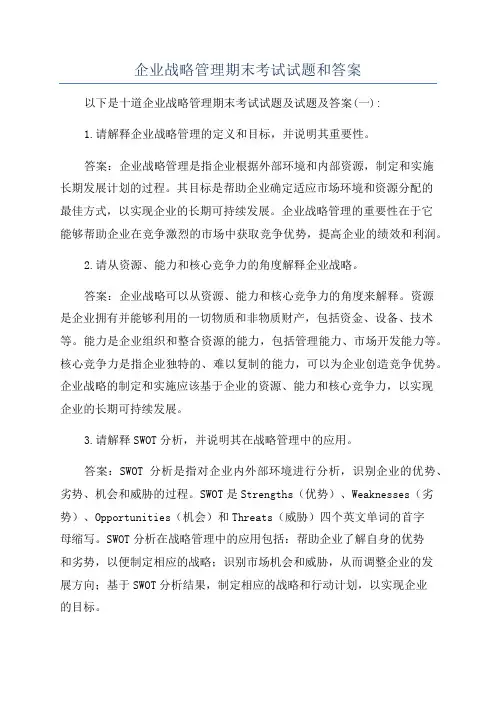
企业战略管理期末考试试题和答案以下是十道企业战略管理期末考试试题及试题及答案(一):1.请解释企业战略管理的定义和目标,并说明其重要性。
答案:企业战略管理是指企业根据外部环境和内部资源,制定和实施长期发展计划的过程。
其目标是帮助企业确定适应市场环境和资源分配的最佳方式,以实现企业的长期可持续发展。
企业战略管理的重要性在于它能够帮助企业在竞争激烈的市场中获取竞争优势,提高企业的绩效和利润。
2.请从资源、能力和核心竞争力的角度解释企业战略。
答案:企业战略可以从资源、能力和核心竞争力的角度来解释。
资源是企业拥有并能够利用的一切物质和非物质财产,包括资金、设备、技术等。
能力是企业组织和整合资源的能力,包括管理能力、市场开发能力等。
核心竞争力是指企业独特的、难以复制的能力,可以为企业创造竞争优势。
企业战略的制定和实施应该基于企业的资源、能力和核心竞争力,以实现企业的长期可持续发展。
3.请解释SWOT分析,并说明其在战略管理中的应用。
答案:SWOT分析是指对企业内外部环境进行分析,识别企业的优势、劣势、机会和威胁的过程。
SWOT是Strengths(优势)、Weaknesses(劣势)、Opportunities(机会)和Threats(威胁)四个英文单词的首字母缩写。
SWOT分析在战略管理中的应用包括:帮助企业了解自身的优势和劣势,以便制定相应的战略;识别市场机会和威胁,从而调整企业的发展方向;基于SWOT分析结果,制定相应的战略和行动计划,以实现企业的目标。
4.请解释竞争优势和价值链,并解释它们之间的关系。
答案:竞争优势是指企业相对于竞争对手在市场上的独特优势,可以帮助企业获得更高的市场份额和利润。
价值链是指企业将原材料转化为最终产品或服务,通过一系列的活动创造价值的过程。
竞争优势和价值链之间的关系在于,企业通过优化和整合价值链的各个环节,可以获得更高的效率和更低的成本,从而实现竞争优势。
企业的竞争优势可以通过价值链的分析和优化来实现。
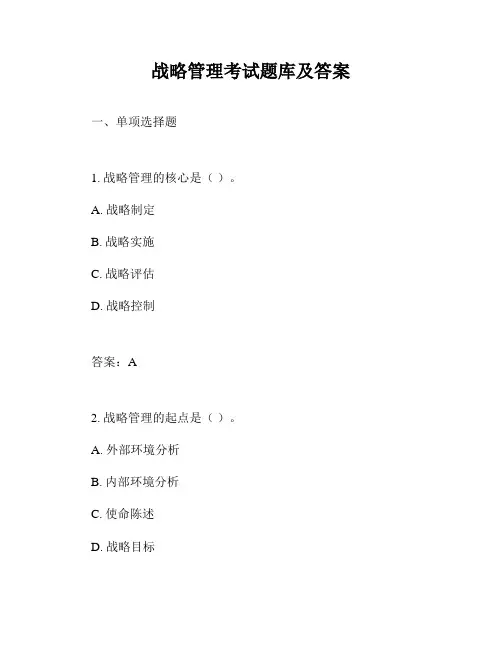
战略管理考试题库及答案一、单项选择题1. 战略管理的核心是()。
A. 战略制定B. 战略实施C. 战略评估D. 战略控制答案:A2. 战略管理的起点是()。
A. 外部环境分析B. 内部环境分析C. 使命陈述D. 战略目标答案:C3. 以下哪项不是战略管理的特点?()A. 整体性B. 长期性C. 灵活性D. 静态性答案:D4. 以下哪项是战略管理的基本任务?()A. 确定企业的使命和目标B. 制定战略C. 实施和执行战略D. 以上都是答案:D5. 企业战略的层次包括()。
A. 总体战略B. 业务单位战略C. 职能战略D. 以上都是答案:D二、多项选择题1. 战略管理过程包括以下哪些步骤?()A. 确定企业的使命和目标B. 外部环境分析C. 内部环境分析D. 选择战略答案:ABCD2. 以下哪些是战略分析工具?()A. SWOT分析B. PEST分析C. 波特五力模型D. 价值链分析答案:ABCD3. 战略实施的模式包括()。
A. 指挥型B. 变革型C. 合作型D. 文化型答案:ABCD4. 以下哪些因素会影响企业的战略选择?()A. 外部环境B. 内部资源和能力C. 竞争对手的战略D. 企业使命和目标答案:ABCD三、判断题1. 战略管理是一个静态的过程。
()答案:错误2. 战略管理只关注企业内部环境。
()答案:错误3. 战略管理的目的是提高企业的竞争力和市场地位。
()答案:正确4. 战略实施是战略管理过程中最简单的一步。
()答案:错误5. 战略评估是战略管理过程的最后阶段。
()答案:正确四、简答题1. 简述战略管理的三个主要任务。
答案:战略管理的三个主要任务包括:(1)确定企业的使命和目标;(2)制定战略;(3)实施和执行战略。
2. 描述SWOT分析的四个主要组成部分。
答案:SWOT分析包括四个主要组成部分:(1)优势(Strengths);(2)劣势(Weaknesses);(3)机会(Opportunities);(4)威胁(Threats)。
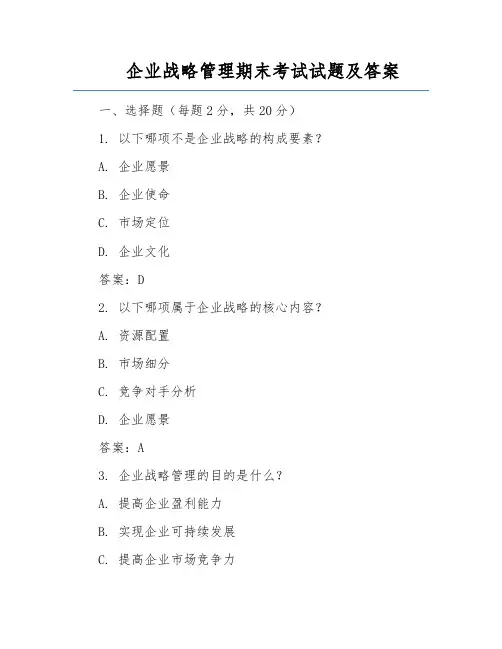
企业战略管理期末考试试题及答案一、选择题(每题2分,共20分)1. 以下哪项不是企业战略的构成要素?A. 企业愿景B. 企业使命C. 市场定位D. 企业文化答案:D2. 以下哪项属于企业战略的核心内容?A. 资源配置B. 市场细分C. 竞争对手分析D. 企业愿景答案:A3. 企业战略管理的目的是什么?A. 提高企业盈利能力B. 实现企业可持续发展C. 提高企业市场竞争力D. 保障企业长期稳定发展答案:D4. 以下哪个战略属于企业总体战略?A. 成本领先战略B. 差异化战略C. 市场细分战略D. 多元化战略答案:D5. 企业在进行战略环境分析时,以下哪项不是需要考虑的因素?A. 政治环境B. 经济环境C. 社会环境D. 企业内部环境答案:D6. 以下哪个战略属于企业业务层战略?A. 成本领先战略B. 差异化战略C. 市场细分战略D. 多元化战略答案:A7. 企业在进行战略评价时,以下哪个指标不属于财务指标?A. 营业收入增长率B. 净利润C. 总资产周转率D. 员工满意度答案:D8. 以下哪个战略属于企业职能战略?A. 成本领先战略B. 差异化战略C. 人力资源战略D. 多元化战略答案:C9. 企业在进行战略规划时,以下哪个步骤是首要的?A. 分析外部环境B. 制定战略目标C. 确定战略方案D. 评估战略方案答案:A10. 以下哪个战略属于企业国际化战略?A. 直接投资B. 出口C. 跨国并购D. 市场细分答案:C二、简答题(每题10分,共40分)1. 简述企业战略的层次。
答案:企业战略分为三个层次:总体战略、业务层战略和职能战略。
2. 简述PEST分析的内容。
答案:PEST分析包括政治环境、经济环境、社会环境和技术环境四个方面的分析。
3. 简述SWOT分析的内容。
答案:SWOT分析包括企业内部的优势(Strengths)、劣势(Weaknesses)、外部机会(Opportunities)和威胁(Threats)四个方面的分析。
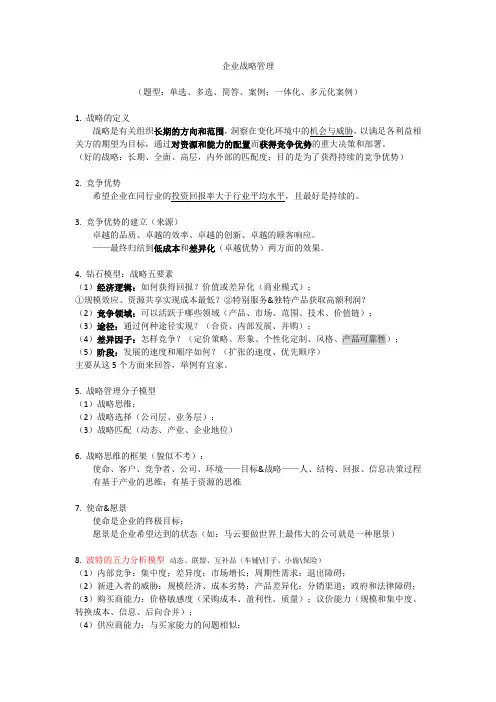
企业战略管理(题型:单选、多选、简答、案例;一体化、多元化案例)1. 战略的定义战略是有关组织长期的方向和范围,洞察在变化环境中的机会与威胁,以满足各利益相关方的期望为目标,通过对资源和能力的配置而获得竞争优势的重大决策和部署。
(好的战略:长期、全面、高层,内外部的匹配度;目的是为了获得持续的竞争优势)2. 竞争优势希望企业在同行业的投资回报率大于行业平均水平,且最好是持续的。
3. 竞争优势的建立(来源)卓越的品质、卓越的效率、卓越的创新、卓越的顾客响应。
——最终归结到低成本和差异化(卓越优势)两方面的效果。
4. 钻石模型:战略五要素(1)经济逻辑:如何获得回报?价值或差异化(商业模式);①规模效应、资源共享实现成本最低?②特别服务&独特产品获取高额利润?(2)竞争领域:可以活跃于哪些领域(产品、市场、范围、技术、价值链);(3)途径:通过何种途径实现?(合资、内部发展、并购);(4)差异因子:怎样竞争?(定价策略、形象、个性化定制、风格、产品可靠性);(5)阶段:发展的速度和顺序如何?(扩张的速度、优先顺序)主要从这5个方面来回答,举例有宜家。
5. 战略管理分子模型(1)战略思维;(2)战略选择(公司层、业务层);(3)战略匹配(动态、产业、企业地位)6. 战略思维的框架(貌似不考):使命、客户、竞争者、公司、环境——目标&战略——人、结构、回报、信息决策过程有基于产业的思维;有基于资源的思维7. 使命&愿景使命是企业的终极目标;愿景是企业希望达到的状态(如:马云要做世界上最伟大的公司就是一种愿景)8. 波特的五力分析模型动态、联盟、互补品(车铺\钉子、小偷\保险)(1)内部竞争:集中度;差异度;市场增长;周期性需求;退出障碍;(2)新进入者的威胁:规模经济、成本劣势;产品差异化;分销渠道;政府和法律障碍;(3)购买商能力:价格敏感度(采购成本、盈利性、质量);议价能力(规模和集中度、转换成本、信息、后向合并);(4)供应商能力:与买家能力的问题相似;(5)替代品:转换的倾向性、性价比;潜在竞争者进入的风险潜在竞争对手是当前不在行业内但是有能力进入本行业的公司,新进入者的壁垒有:(1)规模经济——随着产出增加,单位成本下降,因为·成本降低——大规模制造·大宗采购享受折扣——原材料和标准化部件·成本优势——大规模生产分摊固定成本和营销成本(2)品牌忠诚·通过创建对现有产品的顾客偏好·令新企业难以从现有企业手中夺取市场份额(3)绝对成本优势——相对于新进入企业·累积的经验——制造和关键商业流程·控制生产过程中所需要的特殊生产要素·财务风险低——可以获得更廉价的资金(4)顾客转移成本——对于高转移成本的产品或服务(5)对资金的要求(6)政府管制现有企业间的竞争(*价格战)竞争对手指的是产业内互相竞争市场份额的企业。
企业战略管理期末考试试题及答案[5篇模版]第一篇:企业战略管理期末考试试题及答案企业战略管理考试试题及答案1.在《竞争战略》一书中(A)提出了著名的五种竞争力量模型。
A.波特B.钱德勒C.魁因D.安索夫2.进入壁垒高和退出壁垒高对产业获利能力影响表现为(C)A.稳定的高利润B.稳定的低利润C.高利润高风险D.低利润低风险3.竞争对手各种行为取向的最根本动因是(A)。
A.自我假设B.现行战略C.未来目标D.潜在能力4.久负盛名的“戴尔直销”模式的实质就是(A)。
A.大规模定制B.直销制C.代理制D.连销制5.企业竞争优势的根基是(B)。
A.财务能力B.核心竞争力C.营销能力D.科技能力6.企业通过有效途径降低成本,使企业的全部成本低于竞争对手的成本,甚至在同行业中是最低的成本,从而获取竞争优势的战略是:(A)A.低成本战略B.营销战略C.竞争优势战略D.差异化战略7.集中化战略一般有两种变化形势,一种是低成本集中化,另一种是(A)A差异的集中化B产品线集中化C顾客集中化D地区集中化8.差异化战略的核心是取得某种对顾客有价值的(D)A.可靠性B.信誉性C.实用性D.独特性9.从行业生命周期各阶段的特点来看,市场销售量基本稳定的阶段属于(C)A.导入期B.增长期C.成熟期D.衰退期10.下列哪一项属于动态竞争战略(D)A.成本领先战略B.差异化战略C.集中战略D.进攻战略11.IT行业变化快,是一个典型的(C)A.长周期市场B.标准周期市场C.短周期市场D.不能确定12.通常企业间市场共性越大,企业间攻击的可能性会(B)A.上升B.下降C.不变D.不确定13.对于进攻者来说,随着入侵阶段的上升,其退出障碍越高,所以防御行动最好是在(A)A.准进入阶段B.进入阶段C.持续阶段D.后进入阶段14.理发等个人服务业属于下列哪种属性的行业(D)A.全球市场行业B.多国市场行业C.大宗贸易市场行业D.纯国内市场行业15.寻求全球化的效率和本土化的敏捷反应之间的统一的战略是(C)A.全球化战略B.本土化战略C.跨国化战略D.多元化战略16.企业并不直接参与国外市场的营销活动,主要通过中间商出口产品,这种国际市场进入方式叫(B)A.直接出口B.间接出口C.特许经营D.战略联盟17.通常本国的生产成本高于目标国时,企业进入目标国市场的方式会更倾向于选择(D)A.直接出口B.间接出口C.特许经营D.海外投资18.通过合并、收购同行业竞争企业以增强自身竞争实力的战略称为(A)A、横向一体化战略B、纵向一体化战略C、前向一体化战略D、后向一体化战略19.波斯顿矩阵中的相对市场占有率较高而市场需求量下降的产品群称为(C)A、明星业务B、问号业务C、现金牛业务D、瘦狗业务20.以市场引力、企业实力这两个综合指标来确定产品地位的矩阵图是(A)A、通用矩阵B、大战略矩阵C、波斯顿矩阵D、SWOT矩阵21.在市场增长率——相对市场占有率距阵中,相对市场占有率=本公司某项业务本期销售额/(C)。
战略管理期末试题及答案本文将为您提供战略管理期末试题及答案,以帮助您更好地理解和应用战略管理的知识,提高战略决策能力。
第一部分:选择题1. 以下哪一个不属于战略管理的基本概念?A. 宏观环境分析B. 目标设定与绩效评估C. 内部资源分析D. 企业文化建设答案:D2. SWOT分析是战略管理中常用的工具,其中的“T”代表什么?A. 机会B. 资源C. 威胁D. 优势答案:C3. 下面哪个层次的战略是针对整个企业组织而言的?A. 业务战略B. 功能战略C. 企业级战略D. 战术战略答案:C4. 竞争策略中的“低成本战略”是指企业通过什么手段获得竞争优势?A. 通过提供高品质的产品和服务B. 通过创造独有的市场需求C. 通过降低生产成本来提供更低价格的产品D. 通过与竞争对手建立合作关系答案:C5. 在制定战略时,企业应该根据自身资源和能力选择一个合适的发展方向和战略。
这个过程被称为什么?A. 资源配置B. 目标设定C. 环境分析D. 决策制定答案:A第二部分:简答题1. 请简要概述战略管理的意义和作用。
答案:战略管理是指企业在竞争环境中制定和实施长期发展方向和行动计划的过程。
它的意义和作用主要有以下几个方面:首先,战略管理可以帮助企业识别和理解外部环境的机会和威胁,以及内部资源和能力的优势和劣势,从而指导企业制定适应性战略。
其次,战略管理可以帮助企业明确目标,并建立相应的绩效评估体系,以确保企业的长期竞争力和可持续发展。
此外,战略管理还可以协调和整合企业内部各个部门和功能的工作,形成统一的方向和行动,提高组织的效率和有效性。
2. 请简要介绍SWOT分析的概念和使用方法。
答案:SWOT分析是战略管理中常用的工具,它用于评估企业内部的优势和劣势,以及外部环境中的机会和威胁。
SWOT代表Strengths (优势)、Weaknesses(劣势)、Opportunities(机会)和Threats(威胁)。
2024年《企业战略管理》期末考试复习题库(含答案)一、单选题1.当今世界上竞争战略和竞争力方面公认的第一权威是A、安索夫B,钱德勒G德鲁克D、迈克尔•波特答案:D2-根据对企业经营影响的远近,企业外部环境因素通常被划分为三个层次,其中不包括Ax宏观环境B、微观环境C、市场与行业环境0、竞争与合作环境答案:B3.企业关于未来需要努力实现目的的一种可以精确测量的描述称为A、战略目标B、战略预期Cx战略设想D4战略规划4.属于企业声誉资源的是A、商标B,专利G版权Dv质量标准答案:A5,提出权变理论的战略学派是A、计划学派B、设计学派Cv环境学派D4定位学派答案:C6.战略最基本的内涵是A、战略是一种定位B4战略是一种模式C、战略是一种计划D4战略是一种愿景答案:C7.企业在竞争互动中具有相互矛盾作用的因素是B4规模C4速度D、创新答案:B8.属于稳定型战略的是A、多元化战略B4一体化战略C4谨慎实施战略D4剥离战略答案:C9.某些产业政策和针对特定商务活动的政府干预所带来的企业国际化风险属于Ax财务风险B4经营风险C4经济风险D、政治风险答案:D10.在同一产业链中,处于价值年相同环节上企业间的并购称为A、纵向并购横向并购C4混合并购D4杠杆并购答案:B11.提出计划学派大多数假定的著作是A、安索夫的《企业战略》22.协同效应战略联盟属于A'公司层战略联盟B、业务层战略联盟C4事业层战略联盟D、职能层战略联盟答案:A23.企业的战略目标通常是A4短期的目标B4宏观的目标C、单一性目标D4定量目标答案:B24.全球价值链的概念源于A、波特G德鲁克D、安索夫答案:A25.一般来说.在行业或市场生命周期的后期增长阶段,发挥竞争优势的主要目的是A.提高产品的研发能力B4巩固垄断地位C4迅速扩大生产D4提高市场占有率答案:A26.新兴的企业国际化动因是A、寻求资源Bs学习C4寻求市场D、寻求效率答案:B27.发挥优势减少威胁的应对策略势是A4So策略ST策略DxWT策略答案:B28.20世纪50年代,行业多元化发展的热潮出现在Av英国B'美国C4德国Ds日本答案:B29.届于企业宏观环境中经济环境因素的是4.按照产业组织模式的逻辑战略管理制定的基本步骤。
《企业战略管理》期末考试题及答案企业战略管理是一门涉及企业高层决策和长期规划的学科。
在期末考试中,我们将考察大家对企业战略管理的理解、应用和分析能力。
以下是一份样例试卷及答案,以便大家了解考试内容和题型。
一、单选题(每题1分,共10分)1、下列选项中,不属于企业外部环境分析的方法是: A. SWOT分析B. PEST分析C. 竞争态势分析D. 产品生命周期分析答案:D2、以下关于企业战略联盟的说法不正确的是: A. 战略联盟可以提高企业的竞争力 B. 战略联盟可以减少竞争对手 C. 战略联盟可以确保合作伙伴之间的诚信 D. 战略联盟可以消除外部不确定性答案:D3、在企业战略管理中,以下哪一项不是多元化战略的特点? A. 风险较高 B. 资源共享性 C. 与主业关联性差 D. 市场覆盖范围广答案:A4、下列哪一项不是低成本战略的优势? A. 价格优势 B. 成本优势C. 市场份额优势D. 产品质量优势答案:D5、下列哪一项不属于企业核心竞争力的特点? A. 独特性 B. 动态性 C. 难以模仿性 D. 静态性答案:D6、下列哪一项不是企业战略调整的范围? A. 产品战略调整 B. 组织结构战略调整 C. 产权战略调整 D. 企业文化战略调整答案:C7、下列哪一项不是企业战略执行力的影响因素? A. 人员素质 B. 组织结构 C. 企业文化 D. 激励机制答案:B8、下列哪一项不属于常见的企业战略类型? A. 总成本领先战略 B. 差异化战略 C. 蓝海战略 D. 集中化战略答案:C9、下列哪一项不是企业外部环境分析的意义? A. 帮助企业识别机会和威胁 B. 为企业决策提供依据 C. 有助于企业明确自身优势和劣势 D. 提高企业竞争力答案:D10、下列哪一项不是企业战略管理的原则? A. 系统性原则 B. 全员参与原则 C. 动态性原则 D. 以人为本原则答案:C二、多选题(每题2分,共10分)1、企业外部环境分析的方法包括: A. SWOT分析 B. PEST分析 C. 竞争态势分析 D. 产品生命周期分析 E. 波士顿矩阵分析答案:BCD2、下列哪些是企业战略联盟的优点? A. 提高企业竞争力 B. 减少竞争对手 C. 确保合作伙伴之间的诚信 D. 降低风险 E. 实现资源共享和优势互补答案:ABDE3、下列哪些因素可能会影响企业的核心竞争力? A. 技术创新 B.企业文化 C. 市场营销策略 D. 管理水平 E. 资金实力答案:ABCD 4、企业战略管理的原则包括: A. 系统性原则 B. 全员参与原则 C. 以人为本原则 D. 权变性原则 E. 长期性原则答案:ABD。
战略管理期末试题及答案详解一、简答题:1.什么是战略管理?战略管理是指一个组织或企业为达成其长期目标,制定、实施和监控其战略的过程。
它涉及到对外部环境和内部资源的评估,制定战略目标,并确定实施策略和资源配置的方式。
2.战略管理的主要步骤有哪些?战略管理主要分为以下步骤:- 环境分析:评估外部环境的机会和威胁,内部环境的优势和劣势。
- 制定战略目标:根据环境分析的结果,确定组织的长期目标。
- 制定战略方针和策略:确定实现目标的一般方向和具体行动计划。
- 实施战略:将制定的战略方针和策略付诸实施。
- 监控与评估:对战略实施过程进行监控和评估,确保战略目标的实现。
3.请简要描述SWOT分析的概念和作用。
SWOT分析是指对一个组织或企业进行内部和外部环境评估的方法。
其概念是将Strengths(优势)、Weaknesses(劣势)、Opportunities(机会)和Threats(威胁)四个方面进行分析,以确定组织的竞争优势和发展潜力。
SWOT分析的作用主要有:- 帮助组织了解自身的优势和劣势,为制定战略提供基础。
- 评估外部环境的机会和威胁,以抓住市场机会和应对潜在威胁。
- 为组织的资源配置和决策提供参考依据。
- 发现和利用内外部因素来实施创新和变革。
二、论述题:1.战略管理的意义及实施过程对组织的影响。
战略管理对一个组织具有重大意义和影响。
首先,战略管理使组织能够对内外部环境进行评估,找到自身的优势和劣势、机会和威胁,从而为制定战略目标提供依据。
其次,通过制定战略方针和策略,组织可以明确发展的方向和目标,并将其付诸实施。
战略管理还可以促进资源的有效配置,提升组织的绩效和竞争力。
最后,通过监控与评估,组织可以及时发现问题并采取措施进行调整,保证战略目标的实现。
战略管理的实施过程对组织也有重要的影响。
首先,环境分析可以帮助组织了解市场的机会和威胁,为制定战略提供依据。
其次,战略目标的制定需要明确组织的使命和愿景,以及长期发展的方向。
战略管理期末考试资料整理专业词汇:(30选8)1.Strategic competitiveness 战略竞争力2.Above-average returns 超额利润3.Strategic management process 战略管理过程4.The industrial organization model 行业组织模型5.The resource-based Model 资源基础模型6.Vision and Mission 愿景与使命7.Stake holders 利益相关者8.Industry environment 行业环境9.Integration forward 前向整合petitor analysis 竞争者分析11.distribution 配送12.Marketing 市场营销13.Outsourcing 外包petitive rivalry 竞争性对抗15.Tactical action 战术性行为16.Business-level strategy 业务层战略17.Cost leadership strategy 成本领先战略18.Differention strategy 差异化战略19.Total quality management 全面质量管理20.Corporate-level strategy 公司层战略21.Levels of diversification 多元化水平22.Vertical integration 纵向一体化23.Restructuring of Assets 资产重组24.Merger 合并25.Acquisition 收购26.Takeover 接管27.International strategy 国际化战略28.Global strategy 全球化战略29.Transnational strategy 跨国化战略30.Cooperative strategy 合作战略简答题:1.According to the I/O model,what should a firm do to earn above-aveagereturns?(P15)Answer:1)Study the external environment,especially the industry environment.2)Locate an industry with high potential for above-avevage returns.3)Identify the strategy called for by the attractive industry to earnabove-average returns.4)Develop or acquire assets and skills needed to implement the stragery5)Use the firm’s strengths (its developed or acquired assets and skills) toimplement the strategy.2.What is the external environmental analysis process(four steps)(P30)?Answer:1)Scanning :Identifying early signals of environmental changes andtrends.2)Monitoring:Detecting meaning through ongoing observations ofenvironmental changes and trends.3)Forecasting:Developing projection of anticipated outcomes based onmonitored changes and trends.4)Assessing:Determining the timing and importance of environmentalchanges and trends for firm’s strategies and their management.3.What is value chain analysis?what does the firm gain when it successfullyuses this tool?(P70,P76)Answer:1)Value chain analysis is used to identify and evaluate the competitivepotential of resources and capabilities.2)By studying their skills relative to those associated with primary andsupport activitives,firms can understand their cost structure andidentify the activities through which they can create value.4.What is market commonality?what is resource similarity?(P85) Answer:1)Market commonality is concerned with the number of markets withwhich the firm and a competitor are jointly involved and the degree ofimportance of the individual markets to each.2)Resource similarity is the extent to which the firm’stangible andintangible resources are comparable to a competitor’s in terms of bothtype and amount.5.What are the differences among the cost leadership,differentiation?(P111-116)Answer:1)Firm using the cost leadership strategy commonly sell standavdizedgoods or services to the industry’s most typical customers.Lost leadersconcentrate on finding ways to lower their costs relative to those oftheir competitors by constantly rethinkly how to complete their primaryand support activities to reduce costs still further while maintainingcompetitive levels of differentiation.Research suggests that having acompetitive advantage in terms of logistics creates more value whenusing the cost leadership strategy than when using the differentiationstrategy.2)Differentiators target customers for whom value is created by themanner in which the firm’s products differ from those produced andmarketed by competitors.The firm produces nonstandardized productsfor custmosers who value differentiated features more than theyvalue low cost.Rather than costs,a firm using the differentiationstrategy always concentrates on investing in and developing featuresthat differentiate a good or service in ways that customers value.6.What are three reasons firms choose to diversify their operations?(P133) Answer:①Value-Creating Diversification⑴Economies of scope(related diversification)a)Sharing aactivitiesb)Transferring core competencies⑵Market power(related diversification)a)Blocking competitors through multipoint competitionb)Vertical intrgration⑶Financial econmies(unrelated diversification)Efficient internal capital allocationBusiness restructuring②Value-Newtral Diversification⑴Antitrust regulation ⑵Tax laws ⑶Law performance⑷Uncertain future cash flows ⑸Risk reduction for firm⑹Tangible resources ⑺Intangible resources③Value-Reducing Diversification⑴Diversifying managerial employment risk⑵Increasing managerial compensation7.What are the seven primary problems that affect a fir m’s efforts tosuccessfully use an acquisition strategy?(P172)Answer:1)The difficulty of effectively integrating the firms involved2)Incorrectly evaluating the target firm’s value3)Creating debt loans that preclude adequate long-terminvestments(eg.R&D)4)Overestimating the potential for synergy5)Creating a firm that is too diversified6)Creating an internal environment in which managers devoteincreasing7)Amounts of their time and energy to analyzing and completingthe acquisition8)Developing a combined firm that is toolarge,necessitatingextensive use of bureaucratic,rather thanstrategic,control.8.What are the four primary benefits of an international strategy?(P198)Answer:Four benefits:①increased market size ②earning a return on largeinvestments ③economies of scale and learning ④advantages of locationChapter 1—What is Strategic Management?TRUE/FALSE1.The goal of strategic management is to develop a competitive advantage that ispermanently sustainable.ANS: F PTS: 1 DIF: Medium REF: 52.Average returns are returns in excess of what an investor expects to earn from otherinvestments with a similar amount of risk.ANS: F PTS: 1 DIF: Medium REF: 63.If a firm can earn at least average returns it will be able to survive.ANS: T PTS: 1 DIF: Medium REF: 64.Tangible assets, such as land and capital equipment, are losing their value as sources ofcompetitive advantage in comparison to intangible assets.ANS: T PTS: 1 DIF: Medium REF: 125.Core competencies can be formed only around production or service-provision activitiesof the firm rather than in support activities such as accounting and marketing.ANS: F PTS: 1 DIF: Medium REF: 17Choice1.Above-average returns area. higher profits than the firm earned last year.b. higher profits than the industry averaged over the last 10 years.c. profits in excess of what an investor expects to earn from other investments with a similarlevel of risk.d. profits in excess of what an investor expects to earn from a historical pattern ofperformance of the firm.ANS: C PTS: 1 DIF: Easy REF: 52.Investors in an established firm judge the adequacy of the returns on their investment inrelation to:a. the returns on other investments of similar risk.b. the stock market’s overall performance.c. the industry’s profit pool.d. the prime interest rate.ANS: A PTS: 1 DIF: Easy REF: 53.Apple has reemerged as a significant player in the computer industry. This regenerationhas been attributed mainly to what capability?a. Cost controlb. Innovationc. Economies of scaled. Monopoly powerANS: B PTS: 1 DIF: Easy REF: 7 | 10 | 114.The five forces model suggests that an industry’s profitability is a function of all thefollowing factors EXCEPTa. buyers.b. competitive rivalry.c. suppliers.d. the economic environment.ANS: D PTS: 1 DIF: Medium REF: 135.When resources and capabilities serve as a source of competitive advantage for a firm, thefirm has created a(n)a. strategic mission.b. inspiring vision.c. sustainable market niche.d. core competence.ANS: D PTS: 1 DIF: Easy REF: 176.To have the potential to become sources of competitive advantage, resources andcapabilities must be non-substitutable, valuable, ____, and ____.a. unique, easy to imitate.b. easy to imitate, difficult to implement.c. rare, costly to imitate.d. easy to implement, unique.ANS: C PTS: 1 DIF: Easy REF: 187.The development of a firm’s mission typically involves which of the following?a. Only the CEO.b. The CEO and top managers.c. Only top managers.d. None of the above.ANS: B PTS: 1 DIF: Easy REF: 198.Product market stakeholders includea. suppliers.b. shareholders.c. employees.d. the firm’s chief executive officer.ANS: A PTS: 1 DIF: Easy REF: 22OBJ: 01-06 TYPE: knowledgeNOT: AACSB: Business Knowledge & Analytical Skills | Management: EnvironmentalInfluence | Dierdorff & Rubin: Managing decision-making processesChapter 2—Exploring the External Environment: Competition andopportunities TRUE/FALSE6.The final result of successful strategic competitiveness is above-average returns.ANS: T PTS: 1 DIF: Medium REF: 347.Firms can directly control the elements of the six segments of the general environment.ANS: F PTS: 1 DIF: Easy REF: 358.Monitoring involves the development of a forecast of what might happen at a future pointin time.ANS: F PTS: 1 DIF: Easy REF: 389.In recent years, industry boundaries have become more sharply defined.ANS: F PTS: 1 DIF: Easy REF: 4810.Generally, the stronger the competitive forces, the higher the profit potential of anindustry.ANS: F PTS: 1 DIF: Medium REF: 55MULTIPLE CHOICE1.The ____ environment is composed of elements in the broader society that can influencean industry and the firms within it.a. competitorb. generalc. socioculturald. industryANS: B PTS: 1 DIF: Medium REF: 352.Which of the following is NOT an activity used in the external environmental analysisprocess?a. Scanningb. Monitoringc. Decryptingd. AssessingANS: C PTS: 1 DIF: Medium REF: 37 (Table 2.2) |38-393. A general environmental analysis can be expected to produce all of the followingEXCEPTa. objective answers.b. recognition of environmental changes.c. identification of organizational opportunities.d. identification of organizational threats.ANS: A PTS: 1 DIF: Medium REF: 39-404.An analysis of the economic segment of the external environment would include all of thefollowing EXCEPTa. interest rates.b. international trade.c. the strength of the U.S. dollar.d. the move toward a contingent workforce.ANS: D PTS: 1 DIF: Medium REF: 425.The economic environment refers toa. the economic outlook of the world provided by the World Bank.b. the nature and direction of the economy in which a firm competes or may compete.c. an analysis of how the environmental movement and world economy interact.d. an analysis of how new environmental regulations will affect the U.S. economy.ANS: B PTS: 1 DIF: Medium REF: 426.Which of the five forces of competition is MOST threatening to Google?a. rivalry among competing search enginesb. threat of substitutesc. bargaining power of suppliersd. threat of new entrantsANS: A PTS: 1 DIF: Medium REF: 467.An industry is defined asa. a group of firms producing the same products or services.b. firms producing items that sell through the same distribution channels.c. a group of firms producing products that are close substitutes.d. firms that sell the same products or services to the same customer base.ANS: C PTS: 1 DIF: Easy REF: 48OBJ: 02-02 TYPE: knowledgeNOT: AACSB: Business Knowledge & Analytical Skills | Management: EnvironmentalInfluence | Dierdorff & Rubin: Managing the task environment8.New entrants to an industry are more likely whena. it is difficult to gain access to distribution channels.b. economies of scale in the industry are high.c. product differentiation in the industry is low.d. capital requirements in the industry are high.ANS: C PTS: 1 DIF: Medium REF: 49-519.Suppliers are powerful whena. satisfactory substitutes are available.b. they sell a commodity product.c. they are in a highly fragmented industry.d. they offer a credible threat of forward integration.ANS: D PTS: 1 DIF: Hard REF: 52petitor analysis focuses ona. firms with which the company competes directly.b. firms that produce products that are substitutes.c. all firms in the industry.d. companies that might enter the industry.ANS: A PTS: 1 DIF: Medium REF: 58Chapter 3—Examining the Internal Organization: Resources, Capabilities TRUE/FALSE11.Firms should seek to continually develop new core competencies because all corecompetencies have limited life spans.ANS: T PTS: 1 DIF: Easy REF: 7012.Creating customer value is the source of the firm’s potential to earn above-averagereturns.ANS: T PTS: 1 DIF: Easy REF: 72-7313.In the long run, if an organization does not change it will fail.ANS: T PTS: 1 DIF: Easy REF: 7414.23. Trademarks and copyrights are examples of a firm’s tangible resources.ANS: T PTS: 1 DIF: Easy REF: 76 | 77 (Table 3.1)15.The foundation of all competitive advantages is technology.ANS: F PTS: 1 DIF: Medium REF: 8116.Capabilities may be costly to imitate if they are causally ambiguous or socially complex.ANS: T PTS: 1 DIF: Medium REF: 82MULTIPLE CHOICE1.Which of the following is NOT a factor affecting sustainability of a competitiveadvantage?a. The availability of substitutes for a firm’s core competence.b. The rate at which obsolescence of the core competence occurs because of environmentalchanges.c. The length of time the core competence has existed.d. The limitability of a core competence.ANS: C PTS: 1 DIF: Medium REF: 70-712.Internal analysis enables a firm to determine what the firma. should do.b. can do.c. will do.d. might do.ANS: B PTS: 1 DIF: Medium REF: 713.The most numerous of the following organizational characteristics area. resources.b. capacities.c. capabilities.d. core competencies.ANS: A PTS: 1 DIF: Easy REF: 754.All of the following are tangible resources EXCEPTa. production equipment.b. distribution centers.c. formal reporting structures.d. firm’s reputation.ANS: D PTS: 1 DIF: Medium REF: 77 (Table 3.1)pared to tangible resources, intangible resources area. of less strategic value to the firm.b. not the focus of strategic analysis.c. a more potent source of competitive advantage.d. more likely to be reflected on the firm’s balance sheet.ANS: C PTS: 1 DIF: Medium REF: 786.Which of the following is NOT a reputational resource?a. Customer opinion that the firm’s product are high quality.b. Suppliers’ opinion that the firm pays its bills in a timely manner.c. Employees viewing the firm as a terrible place to work.d. Customer opinion that using the firm’s product makes them attractive.ANS: C PTS: 1 DIF: Hard REF: 787.Capabilities that other firms cannot develop easily are classified asa. costly to imitate.b. rare.c. valuable.d. nonsubstitutable.ANS: A PTS: 1 DIF: Easy REF: 828.Firms that achieve competitive parity can expect toa. earn average returns.b. earn below-average returns.c. earn above-average returns.d. initially earn above-average returns, declining to average returns.ANS: A PTS: 1 DIF: Easy REF: 84 (Table 3.5) 9.Value chain analysis is a tool used toa. analyze a firm’s exte rnal environment for value-creating opportunities.b. analyze a firm’s primary and support activity in isolation from influences of the externalenvironment.c. understand the parts of the firm’s operation that create value and those that do not.d. ide ntify the firm’s core competencies in each of the primary activities of the firm.ANS: C PTS: 1 DIF: Hard REF: 8510.Outsourcing is thea. spinning off of a value-creating activity to create a new firm.b. purchase of a value-creating activity from an external supplier.c. selling of a value-creating activity to other firms.d. use of computers to obtain value-creating data from the Internet.ANS: B PTS: 1 DIF: Medium REF: 87Chapter 4—Building and Sustaining Competitive AdvantageTRUE/FALSE17.Firms operating in the same market, offering similar products and targeting similarcustomers are competitors.ANS: T PTS: 1 DIF: Easy REF: 12818.“Competitive dynamics” indicates that firms and their strategic actions are independent.ANS: F PTS: 1 DIF: Medium REF: 12819.Intensified rivalry within an industry results in decreased average profitability for thefirms within it.ANS: T PTS: 1 DIF: Medium REF: 13020.Under the framework of competitive action and response, “ability” refers to an attackingor responding firm’s know ledge of the competitive market characteristics.ANS: F PTS: 1 DIF: Easy REF: 13321.Product quality is a universal theme and is a necessary, but not a sufficient, condition forcompetitive success.ANS: T PTS: 1 DIF: Medium REF: 14022.The more dependent a firm is on its market, the more aggressively it will defend it fromanother competitor.ANS: T PTS: 1 DIF: Medium REF: 143MULTIPLE CHOICEpetitive rivalry has the most effect on the firm’s ____ strategies than the firm’s otherstrategies.a. business-levelb. corporate-levelc. acquisitiond. internationalANS: A PTS: 1 DIF: Easy REF: 1282.Which pair of firms has the greatest market commonality?a. Microsoft and Lenovob. HP and Microsoftc. Dell and Microsoftd. HP and DellANS: D PTS: 1 DIF: Medium REF: 133 | 127-1283.11. In general, firms are more aware of competitors who have similar resources and whoa. have low market dependence.b. compete against the firm in multiple markets.c. have low market commonality.d. are late movers.ANS: B PTS: 1 DIF: Medium REF: 133petitive action can be one of two types, either ____ or ____.a. aggressive, defensiveb. strategic, tacticalc. quality-based, cost-basedd. market-based, resource-basedANS: B PTS: 1 DIF: Easy REF: 1365. A second movera. is typically ineffective in its response to the first mover.b. attempts to provide a product with greater customer value than the first mover’s product.c. usually incurs higher expenses than the first mover since it must engage in reverseengineering.d. typically has a higher survival rate than first movers which typically take greater risks.ANS: B PTS: 1 DIF: Medium REF: 138-1396.Without quality, the firm’s productsa. can compete effectively on the basis of low price.b. must be exported to developing countries, because they are not competitive in the U.S. ordeveloped countries.c. lack credibility among customers.d. are associated with predatory competition.ANS: C PTS: 1 DIF: Easy REF: 140-1417. A firm is likely to respond to an attack by a competitor in all of the following situationsEXCEPTa. the attack is by a price predator.b. the attack makes the firm’s market position less defensible.c. the attack damages the firm’s ability to use its capabilities.d. the attack improves the competitor’s market position.ANS: A PTS: 1 DIF: Medium REF: 142-1438.Sustained competitive advantage is most achievable in a ____ market.a. slow-cycleb. medium-cyclec. standard-cycled. fast-cycleANS: A PTS: 1 DIF: Medium REF: 143Chapter5—Business-Level StrategyTRUE/FALSE23.The goal of business-level strategy is to earn above-average returns.ANS: T PTS: 1 DIF: Medium REF: 9824.A business-level strategy is an integrated and coordinated set of commitments and actionsdesigned to exploit core competencies and gain a competitive advantage in specificproduct markets.ANS: T PTS: 1 DIF: Medium REF: 9825.A low-cost position in the industry is not a valuable defense against rivals whencompeting on the basis of price.ANS: F PTS: 1 DIF: Medium REF: 106-10926.A risk of the differentiation strategy is that the firm’s means of differentiation mayeventually not provide value to the customer.ANS: T PTS: 1 DIF: Easy REF: 110-11327.A flexible manufacturing system is a computer-controlled process used to produce avariety of products in moderate, flexible quantities with minimal manual intervention.ANS: T PTS: 1 DIF: Medium REF: 11928.A customer relationship management system will allow firms to identify the trade-offsthat customers are willing to make between differentiated features and low cost.ANS: T PTS: 1 DIF: Easy REF: 119-120 MULTIPLE CHOICE1. A firm’s core strategy is its ____ strategy.a. corporateb. pricingc. businessd. internationalANS: C PTS: 1 DIF: Easy REF: 982.When selecting a business level strategy, the firm must determine all of the followingEXCEPTa. How will the customer’s needs be satisfied?b. Who is the customer?c. What are the customers’ needs?d. Why should these customers’ needs be satisfied?ANS: D PTS: 1 DIF: Medium REF: 993.Before the firm decides what products to offer and what benefits and features they willhave, the firm must decide all the following questions EXCEPTa. who the firm should serve.b. what core competencies are needed to satisfy customer needs.c. what needs the firm should satisfy.d. when the customer’s needs should be satisfied.ANS: D PTS: 1 DIF: Medium REF: 101-1034.Business-level strategies are concerned specifically witha. creating differences between the firm’s position and its rivals.b. selecting the industries in which the firm will compete.c. how functional areas will be organized within the firm.d. how a business with multiple physical locations will operate one of those locations.ANS: A PTS: 1 DIF: Medium REF: 1035.Which value creating strategies best satisfy customer needs?a. Firm resourcesb. Capabilitiesc. None of the above.d. Core competenciesANS: D PTS: 1 DIF: Medium REF: 103-1046. A cost leadership strategy provides goods or services with features that area. acceptable.b. unique.c. substandard.d. mediocre.ANS: A PTS: 1 DIF: Easy REF: 1067. A company pursuing the differentiation or focused differentiation strategy would tend toa. have highly efficient systems linking suppliers’ products with the firm’s productionprocesses.b. have strong capabilities in basic research.c. use economies of scale.d. make investments in easy-to-use manufacturing technologies.ANS: B PTS: 1 DIF: Medium8.When a product’s unique attributes provide value to customers, the firm is implementinga. a differentiation strategy.b. a cost leadership strategy.c. an integrated cost leadership/differentiation strategy.d. a single-product strategy.ANS: A PTS: 1 DIF: Medium REF: 1109.54. The focused differentiation strategy differs from the differentiation strategy in thata. the focused differentiators have a broader competitive scope.b. the value-creating activities of focused differentiators are more constrained.c. there are fewer risks with the focused differentiation strategy.d. focused differentiators target a narrower customer market.ANS: D PTS: 1 DIF: Medium REF: 116-11710.The integration of a cost leadership and a differentiation strategya. is challenging because of the inherent difficulties in balancing primary and supportactivities.b. forces a firm to adapt more slowly to changes in its environment.c. allows the firm to avoid being “stuck in the middle.”d. requires such a large customer base that it is most practical for firms in the globalmarketplace.ANS: A PTS: 1 DIF: Hard REF: 117 | 119 Chapter 6—Corporate-Level StrategyTRUE/FALSE29.A business-level strategy indicates product markets and businesses in which the firmshould compete.ANS: F PTS: 1 DIF: Medium REF: 15430.Successful product diversification is expected to increase the variabil ity in the firm’sprofitability, since the earnings are generated from several different business units.ANS: F PTS: 1 DIF: Easy REF: 15531.Corporate level core competencies are resources and capabilities held within specificbusiness units within the corporate portfolio.ANS: F PTS: 1 DIF: Medium REF: 16032.As product markets become worldwide, we can expect that multipoint competition willdecrease.ANS: F PTS: 1 DIF: Medium REF: 16133.When implementing a restructuring strategy a company would do best by focusing onmature, low-technology businesses.ANS: T PTS: 1 DIF: Medium REF: 166MULTIPLE CHOICE1.On the most basic level, corporate-level strategy is concerned with ____ and how tomanage these businesses.a. whether the firm should invest in global or domestic businessesb. what product markets and businesses the firm should be inc. whether the portfolio of businesses should generate immediate above-average returns orshould be troubled businesses which will create above-average returns only afterrestructuringd. whether to integrate backward or forward.ANS: B PTS: 1 DIF: Medium REF: 154ually a company is classified as a single business firm when revenues generated by thedominant business are greater than ____ percent.a. 99b. 90c. 95d. 70ANS: C PTS: 1 DIF: Medium REF: 155 | 158 (Figure 6.1)3.GE has recently reorganized from eleven businesses down to six core businesses. Thepurpose of this reorganization is to transfer core competencies in different types oftechnologies among GE’s businesse s. This is an example ofa. increasing market power through vertical integration.b. efficient internal capital allocation.c. a focus on financial economies.d. increasing corporate relatedness.ANS: D PTS: 1 DIF: Medium REF: 156-1574.Firms seek to create value from economies of scope through all of the following EXCEPTa. de-integration.b. skill transfers.c. transfers of corporate core competencies.d. activity sharing.ANS: A PTS: 1 DIF: Easy REF: 1595.The basic types of operational economies through which firms seek value from economiesof scope area. synergies between internal and external capital markets.b. the leveraging of individual tangible resources.c. joint ventures and outsourcing.d. the sharing of primary and support activities.ANS: D PTS: 1 DIF: Medium REF: 1596.The purchasing of firms in the same industry is called:a. unrelated diversification.b. vertical integration.c. networking the organization.d. horizontal acquisition.ANS: D PTS: 1 DIF: Easy REF: 1607.Acquisitions to increase market power require that the firm have a ____ diversificationstrategy.a. relatedb. unrelatedc. dominant-businessd. single businessANS: A PTS: 1 DIF: Hard REF: 1618.Backward integration occurs when a companya. produces its own inputs.b. owns its own source of distribution of outputs.c. is concentrated in a single industry.d. is divesting unrelated businesses.ANS: A PTS: 1 DIF: Medium REF: 1629.Successful unrelated diversification through restructuring is typically accomplished bya. a “random walk” of good luck in picking firms to buy.b. focusing on mature, low-technology businesses.c. seeking out high technology firms in high growth industries.d. a top management team that is not constrained by pre-established ideas of how the firm’sportfolio should be developed.ANS: A PTS: 1 DIF: Easy REF: 16610.External incentives to diversify includea. the fact that other firms in an industry are diversifying.b. pressure from stockholders who are demanding that the firm diversify.c. changes in antitrust regulations and tax laws.d. a firm’s low performance.ANS: C PTS: 1 DIF: Easy REF: 168pared with diversification based on intangible resources, diversification based onfinancial resources isa. less imitable and less likely to create value on a long-term basis.b. more imitable and more likely to create value on a long-term basisc. less imitable and more likely to create value on a long-term basis。